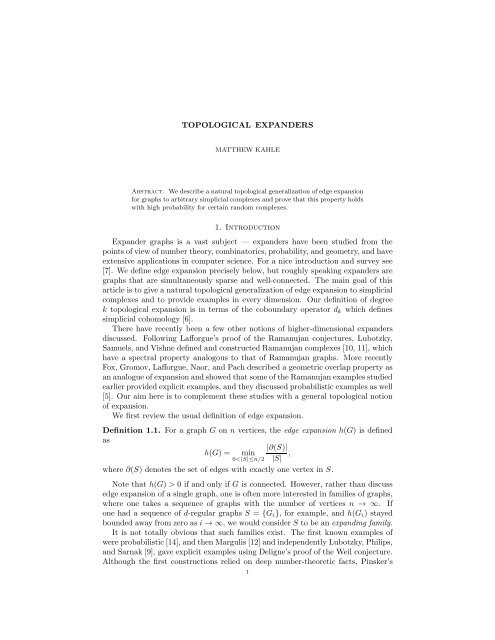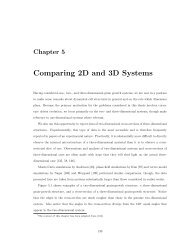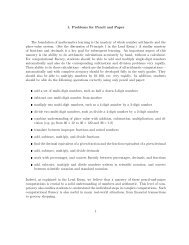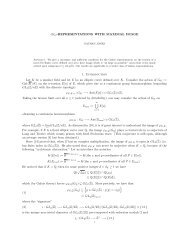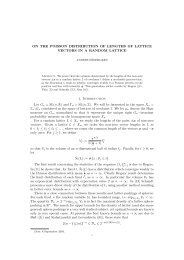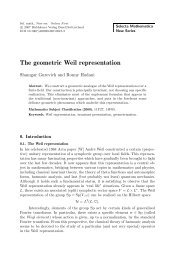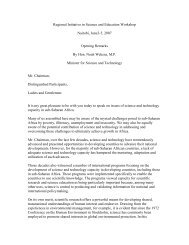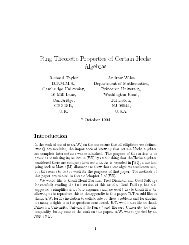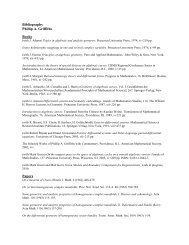TOPOLOGICAL EXPANDERS 1. Introduction Expander graphs ... - IAS
TOPOLOGICAL EXPANDERS 1. Introduction Expander graphs ... - IAS
TOPOLOGICAL EXPANDERS 1. Introduction Expander graphs ... - IAS
Create successful ePaper yourself
Turn your PDF publications into a flip-book with our unique Google optimized e-Paper software.
<strong>TOPOLOGICAL</strong> <strong>EXPANDERS</strong><br />
MATTHEW KAHLE<br />
Abstract. We describe a natural topological generalization of edge expansion<br />
for <strong>graphs</strong> to arbitrary simplicial complexes and prove that this property holds<br />
with high probability for certain random complexes.<br />
<strong>1.</strong> <strong>Introduction</strong><br />
<strong>Expander</strong> <strong>graphs</strong> is a vast subject — expanders have been studied from the<br />
pointsofviewofnumbertheory, combinatorics,probability, andgeometry,andhave<br />
extensive applications in computer science. For a nice introduction and survey see<br />
[7]. We define edge expansion precisely below, but roughly speaking expanders are<br />
<strong>graphs</strong> that are simultaneously sparse and well-connected. The main goal of this<br />
article is to give a natural topological generalization of edge expansion to simplicial<br />
complexes and to provide examples in every dimension. Our definition of degree<br />
k topological expansion is in terms of the coboundary operator d k which defines<br />
simplicial cohomology [6].<br />
There have recently been a few other notions of higher-dimensional expanders<br />
discussed. Following Lafforgue’s proof of the Ramanujan conjectures, Lubotzky,<br />
Samuels, and Vishne defined and constructed Ramanujan complexes [10, 11], which<br />
have a spectral property analogous to that of Ramanujan <strong>graphs</strong>. More recently<br />
Fox, Gromov, Lafforgue, Naor, and Pach described a geometric overlap property as<br />
ananalogueofexpansionandshowedthat someoftheRamanujanexamplesstudied<br />
earlierprovidedexplicit examples, and they discussedprobabilisticexamples aswell<br />
[5]. Our aim here is to complement these studies with a general topological notion<br />
of expansion.<br />
We first review the usual definition of edge expansion.<br />
Definition <strong>1.</strong><strong>1.</strong> For a graph G on n vertices, the edge expansion h(G) is defined<br />
as<br />
|∂(S)|<br />
h(G) = min ,<br />
0 0 if and only if G is connected. However, rather than discuss<br />
edge expansion of a single graph, one is often more interested in families of <strong>graphs</strong>,<br />
where one takes a sequence of <strong>graphs</strong> with the number of vertices n → ∞. If<br />
one had a sequence of d-regular <strong>graphs</strong> S = {G i }, for example, and h(G i ) stayed<br />
bounded away from zero as i → ∞, we would consider S to be an expanding family.<br />
It is not totally obvious that such families exist. The first known examples of<br />
wereprobabilistic[14], andthen Margulis[12]andindependently Lubotzky, Philips,<br />
and Sarnak [9], gave explicit examples using Deligne’s proof of the Weil conjecture.<br />
Although the first constructions relied on deep number-theoretic facts, Pinsker’s<br />
1
2 MATTHEW KAHLE<br />
earlier observation was that a sequence of random d-regular <strong>graphs</strong> already gives<br />
an edge-expanding family with probability <strong>1.</strong><br />
Although one often studies expansion for a sequence d-regular <strong>graphs</strong>, we need<br />
not be restricted to <strong>graphs</strong> of bounded degree, or even to regular <strong>graphs</strong>. For<br />
example, Erdős-Rényi random <strong>graphs</strong> G(n,p) are also known to have strong edge<br />
expansion properties as n → ∞ [2] once p ≫ logn/n. (We use ≫ and ≪ loosely,<br />
meaning “much greater than,” or “much less than.”)<br />
Definition <strong>1.</strong>2. The Erdős-Rényi random graph G(n,p) is the probability space<br />
of all <strong>graphs</strong> on vertex set [n] = {1,2,...,n} with each edge having probability p,<br />
independently. In other words for every graph G on vertex set [n],<br />
Prob[G ∈ G(n,p)] = p e(G) (1−p) (n 2)−e(G) ,<br />
where e(G) denote the number of edges of G.<br />
We say that G(n,p) asymptotically almost surely (a.a.s. ) has property P if for<br />
G ∈ G(n,p),<br />
Prob[G ∈ P] → 1<br />
as n → ∞.<br />
The following theorem is due to Erdős and Rényi [4].<br />
Theorem <strong>1.</strong>3. Let ω = ω(n) be any function that tends to infinity with n. If<br />
p = (logn + ω)/n then G(n,p) is a.a.s. connected, and if p = (logn − ω)/n then<br />
G(n,p) is a.a.s. disconnected.<br />
Once p is much larger than logn/n, G(n,p) exhibits strong edge expansion. The<br />
following theorem is due to Benjamini, Haber, Krivelevich, and Lubetzky [2]. Let<br />
δ(G) denote the minimum degree of G.<br />
Theorem <strong>1.</strong>4. Let ǫ > 0 and 0 < c < 1/2 be constants and p ≥ (1 + ǫ)logn/n.<br />
Then a.a.s. G ∈ G(n,p) has edge expansion bounded below by<br />
h(G) > cδ(G).<br />
A few comments about Theorem <strong>1.</strong>4 are in order.<br />
(1) The importance of the function logn/n is that if p ≪ logn/n then G ∈<br />
G(n,p) is a.a.s. disconnected, in which case h(G) = 0.<br />
(2) For every graph G we have h(G) ≤ δ(G), so this is the best rate of growth<br />
of edge expansion that one might hope for.<br />
(3) The 1/2 in this statement of Theorem <strong>1.</strong>4 can not be improved, since the<br />
edge expansion of the complete graph K n is given by h(K n ) = (n −1)/2,<br />
and we are getting closer to this case as the edge probability p gets closer<br />
to <strong>1.</strong><br />
(4) For every vertex v the expectation of the degree deg(v) is given by<br />
E[deg(v)] = p(n−1) ≈ pn.
<strong>TOPOLOGICAL</strong> <strong>EXPANDERS</strong> 3<br />
Once p ≥ (1+ǫ)logn/n, a.a.s. every vertex degree is tightly concentrated<br />
around this mean.<br />
Linial and Meshulam defined 2-dimensional analogues of G(n,p) and proved a<br />
cohomological analogue of Theorem <strong>1.</strong>3 [8], and Meshulam and Wallach extended<br />
the result to arbitrary dimension [13].<br />
Let ∆ n denote the (n−1)-dimensional simplex and ∆ n i its i-skeleton.<br />
Definition <strong>1.</strong>5. The random simplicial complex Y d (n,p) is the probability space<br />
of all simplicial complexes with complete (d −1)-skeleton and each d-dimensional<br />
face appearing independently with probability p. In other words for every<br />
we have<br />
∆ n d−1 ⊆ Y ⊆ ∆n d ,<br />
Prob(Y ∈ Y d (n,p)) = p fi(Y) (1−p) ( n<br />
i+1)−f i(Y ) ,<br />
where f i denotes the number of i-dimensional faces of Y.<br />
Let R be any (fixed) finite coefficient ring. The main results of [8] and [13] for<br />
Y ∈ Y(n,p) is the following.<br />
Theorem <strong>1.</strong>6. Let ω = ω(n) be any function that tends to infinity with n. If<br />
p = (k+1)logn+ω<br />
n<br />
then a.a.s. H k (Y,R) = 0 and if p = (k+1)logn−ω<br />
n<br />
then a.a.s.<br />
H k (Y,R) ≠ 0.<br />
The case k = 1 and R = Z/2 was proved in [8] and the general case in [13]. Note<br />
that k = 0 is exactly Theorem <strong>1.</strong>3. One of the main ideas in proving Theorem <strong>1.</strong>6<br />
is an isoperimetric inequality for ∆ n (or ∆ n k+1<br />
), which we describe next.<br />
Fix a coefficient ring R, and for a simplicial complex S let C k (S) denote the<br />
set of k-cochains of S, i.e. C k (S) = {f : S(k) → R}, where S(k) is the set of<br />
k-dimensional faces of S. Let d k : C k → C k+1 denote the simplicial coboundary<br />
map (see for example [6]).<br />
Definition <strong>1.</strong>7. For a simplicial complex S and φ ∈ C k (S) define<br />
and<br />
w(φ) =<br />
b(φ) = |supp(d k (φ))|,<br />
min |supp(φ+d k−1 (X)|.<br />
X∈C k−1 (S)<br />
Here supp(A) denotes the support of A, i.e. supp(A) = {σ ∈ S(k) | A(σ) ≠ 0}, and<br />
|·| denotes the cardinality of a set.<br />
A useful isoperimetric inequality observed by Linial, Meshulam, and Wallach is<br />
the following.<br />
Lemma <strong>1.</strong>8. For every φ ∈ C k (∆ n ),<br />
b(φ) ≥ n<br />
k +1 w(φ).<br />
For a short self-contained proof and examples to show that the constant<br />
1<br />
k+1<br />
is best possible, see [13]. What we are interested in here is whether a similar<br />
inequality might hold for much sparser simplicial complexes. This motivates the<br />
following definition, which is the first main point of this article.
4 MATTHEW KAHLE<br />
Definition<strong>1.</strong>9. ForasimplicialcomplexS definethedegree k topological expansion<br />
h k (S) by<br />
b(φ)<br />
h k (S) = min<br />
{φ∈C k (S)|w(φ)≠0} w(φ) .<br />
Note that when k = 0 this agrees exactly with the usual definition of edge<br />
expansion for <strong>graphs</strong>. First of all, if we talk about sets of vertices and edges, this is<br />
reallyworkingwith R = Z/2coefficients. Second, ifweworkin reducedcohomology<br />
then the coboundary of the empty set is the set of all n vertices. So for every subset<br />
of vertices φ, we have w(φ) = min(|φ|,n −|φ|), or said another way w(φ) = |φ| if<br />
and only if |φ| ≤ n/2. Clearly b(φ) is the number of edges with one end in φ.<br />
Wealsonotethath k (S) > 0ifandonlyifthekth cohomologyH k (S,R)vanishes.<br />
To see this note that b(φ) = 0 if and only if φ is a cocycle, and w(φ) = 0 if and only<br />
if φ is a coboundary. So we only have h k (S) = 0 if there is some k-cocycle which is<br />
not a coboundary, i.e. a nontrivial element of kth cohomology.<br />
Continuing the analogy with edge expansions of <strong>graphs</strong>, we expect this to be<br />
most interesting for sequences of simplicial complexes where the number of vertices<br />
n → ∞, and where the properly renormalized degree k topological expansion stays<br />
bounded away from zero. To discuss the proper renormalization we introduce the<br />
following notation. For a simplicial complex S and k ≥ 0, set<br />
δ k (S) = min #(k +1)-dimensional faces in S(k+1) containing σ.<br />
σ∈S(k)<br />
Just as h(G) ≤ δ(G) for a graph G, it is easy to see more generally that h k (S) ≤<br />
δ k (S) for a simplicial complex S. So we might think of a sequence of simplicial<br />
complexes {S i } i∈N as an expanding family if h k (S i )/δ k (S i ) stays bounded away<br />
from zero as i → ∞. The second main point of this article is to show that the<br />
random complexes Y d (n,p) provide such examples once p ≫ logn<br />
n .<br />
2. Main result<br />
Fix a finite coefficient ring R and k ≥ <strong>1.</strong> Our main result is the following.<br />
Theorem 2.<strong>1.</strong> For every ǫ > 0 there exists C = C(ǫ) such that for p ≥ C logn<br />
n<br />
and<br />
Y ∈ Y k+1 (n,p) we have a.a.s.<br />
( ) 1<br />
h k (Y) ><br />
k +1 −ǫ δ k (Y).<br />
1<br />
The constant<br />
k+1<br />
can not be improved for these complexes, since the bound in<br />
Lemma<strong>1.</strong>8isbest possible, andthisis thelimiting caseasp → <strong>1.</strong> As Theorem<strong>1.</strong>6is<br />
a generalization of Theorem <strong>1.</strong>3 to higher dimensions, Theorem 2.1 a generalization<br />
of Theorem <strong>1.</strong>4 (although our constant C is probably not optimal).<br />
Proof of Theorem 2.<strong>1.</strong> We follow a similar counting argument to that in [8] and<br />
[13], but can afford to be much coarser here since we make no effort to optimize<br />
the constant C.<br />
First we note that once p ≥ Clogn/n with C > k standard large deviation<br />
bounds that a.a.s. every k-face σ satisfies deg(σ) ≈ pn, so in particular δ k (Y) ≈ pn<br />
[3]. A more precise statement is that a.a.s. δ(Y)(1−o(1))pn, but to ease notation<br />
we occasionally just replace δ k (Y) by pn.<br />
Given a cochain φ ∈ C k (Y) we desire to put a lower bound on b(φ) in terms of<br />
w(φ). There is a natural inclusion i : Y ֒→ ∆ n k+1 , and we let ˜φ denote the “image”
<strong>TOPOLOGICAL</strong> <strong>EXPANDERS</strong> 5<br />
of φ in C k (∆ n k+1<br />
). Cochains normally pull back rather than push forward, but this<br />
makes sense here because Y and ∆ n k+1<br />
share the same (complete) k-skeleton, and<br />
for the same reason we have w(φ) = w(˜φ).<br />
By Lemma <strong>1.</strong>8 we have that b(˜φ) ≥ n<br />
k+1 w(˜φ). It is easy to see that b(φ) =<br />
|supp(d k (˜φ)) ∩ Y|. By writing b(φ) as a sum of indicator random variables for<br />
the k-faces in supp(d k (˜φ)) we see that has a binomial distribution S N,p where<br />
N = |supp(d k (˜φ)| = b(˜φ) ≥ n<br />
k+1 w(˜φ); see for example the introduction of [3]. Now<br />
we can use large deviation bounds for binomial random variables. For example<br />
Theorem <strong>1.</strong>7 in [3] states that if 0 < p < 1/2, p(1−p)N ≥ 12, and 0 < c < 1<br />
12 then<br />
we have<br />
Prob(|S N,p −pN| ≥ cpN) ≤ (cpN) −1/2 e −c2 pN/3<br />
Set c = ǫ<br />
k+1<br />
. If w(φ) = i ≥ 1 then<br />
[ b(φ)<br />
Prob<br />
= Prob<br />
( ) 1<br />
w(φ) ≤ k +1 −ǫ [<br />
b(φ) ≤<br />
( 1<br />
k +1 −ǫ )<br />
pni<br />
≤ Prob[|S N,p −pN| ≥ cNp]<br />
≤ (cpN) −1/2 e −c2 pN/3<br />
≤ e −c2 pni/3(k+1)<br />
]<br />
δ k (Y)<br />
]<br />
We apply(<br />
a union bound for the event that there exists a cochain φ ∈ C k (Y)<br />
with b(φ)<br />
w(φ) ≤ 1<br />
k+1<br />
)δ −ǫ k (Y). Note that a simple upper bound on the total number<br />
of cochains with w(φ) = i is given by<br />
(( n<br />
))<br />
|{φ ∈ C k (Y) | w(φ) = i}| ≤<br />
k+1<br />
(r−1) i ,<br />
i<br />
where r is the cardinality of our finite coefficient ring R. So the total probability<br />
of a bad cochain is at most<br />
∑∣<br />
∣{φ ∈ C k (Y) | w(φ) = i} ∣ [ ( ])<br />
1<br />
Prob b(φ) ≤ i<br />
k +1 −ǫδ k(Y)<br />
i≥1<br />
(( n<br />
))<br />
k+1<br />
(r −1) i e −c2 pni/3(k+1)<br />
≤ ∑ i<br />
i≥1<br />
≤ ∑ ( n<br />
k+1<br />
i<br />
i≥1<br />
n (k+1)i<br />
)<br />
(r−1) i e −c2 pni/3(k+1)<br />
≤ ∑ (r −1) i e −c2 pni/3(k+1)<br />
i!<br />
i≥1<br />
≤ ∑ ( en k+1 ) i<br />
(r −1)<br />
( ) i<br />
e −c2 pn/3(k+1) ,<br />
i<br />
i≥1<br />
this last step by Stirling’s approximation i! ≥ (i/e) i .
6 MATTHEW KAHLE<br />
Now write p = C logn<br />
n<br />
. Choose any C > 3(k+1)2<br />
c 2<br />
and write c 1 = k +1− c2 C<br />
3(k+1) .<br />
By choice of C we have that c 1 > 0.<br />
Hence the probability that we have any cochain violating the expansion isoperimetric<br />
inequality is bounded above by<br />
∑<br />
( en k+1 ) i<br />
(r −1)<br />
( ) i<br />
e −c2 pn/3(k+1)<br />
i<br />
i≥1<br />
= ∑ ( en k+1 (r −1)<br />
i<br />
i≥1<br />
≤ ∑ ( en k+1 (r −1)<br />
i<br />
i≥1<br />
) i (<br />
e −c2 C logn/3(k+1) ) i<br />
) i (<br />
n −c2 C/3(k+1) ) i<br />
≤<br />
≤<br />
≤<br />
( k+1)<br />
n<br />
∑<br />
( en<br />
−c 1<br />
(r −1)<br />
i<br />
i≥1<br />
( k+1)<br />
n<br />
∑ (<br />
en<br />
−c 1<br />
(r −1) ) i<br />
i≥1<br />
) i<br />
e(r −1)n −c1<br />
1−e(r−1)n −c1 → 0<br />
as n → ∞.<br />
This proves the theorem, and in particular we see that since c = ǫ<br />
k+1 , choosing<br />
(<br />
C > 3(k+1)4<br />
ǫ<br />
and setting p ≥ Clogn/n is sufficient to ensure that a.a.s. h 2<br />
k (Y) ≥<br />
1<br />
k+1<br />
)δ −ǫ k (Y).<br />
□<br />
3. Comments<br />
Wehavediscussedwhatseemstobethenaturaltopologicalgeneralizationofedge<br />
expansion to higher-dimensional simplicial complexes. Linial, Meshulam, and Wallach<br />
had already observed that (k+1)-dimensional skeletons of (n−1)-dimensional<br />
simplexes ∆ n k+1<br />
already meet this definition, and we have extended their results for<br />
vanishingofcohomologytoshowthatinroughlythesameregimewherecohomology<br />
vanishes we have sparse examples of degree k topological expanders.<br />
Their results and ours depend on the coefficient ring R being finite, and it would<br />
be interesting to know what happens, say, for Z coefficients. On a related note, it<br />
was recently showed by Babson, Hoffman, and Kahle that in the k = 2 case the<br />
threshold for vanishing of π 1 (Y) is quite different than the threshold for H 1 (Y,R),<br />
and along the way they establish linear isoperimetric inequalities on π 1 (Y) [1],<br />
showing that area A(γ) ≤ cL(γ) for some constant c and all contractible curves γ.<br />
This seems to be a different, but perhaps complementary, kind of isoperimetry to<br />
what is discussed here.<br />
As mentionedinthe introduction, otherexamplesof“expanding”simplicialcomplexes<br />
have been considered. For example, it is known that if one takes the clique
<strong>TOPOLOGICAL</strong> <strong>EXPANDERS</strong> 7<br />
complex of a particular Cayley graph on PGL r (F p m), the resulting simplicial complex<br />
has interesting spectral properties [10, 11], and also geometric overlap properties<br />
[5]. Since there are several closely related notions of expansion for <strong>graphs</strong>, it<br />
would be interesting to know whether these Ramanujan complexes are also topological<br />
expanders in the sense described here. At the moment we do not have any<br />
explicit examples of topological expanders for k ≥ 1, and these would seem to be<br />
natural candidates.<br />
Acknowledgements I thank Noga Alon, Eric Babson, Dominic Dotterrer, and<br />
Larry Guth for several helpful and inspiring conversations.<br />
References<br />
[1] Eric Babson, Christopher Hoffman, and Matthew Kahle. The fundamental group of random<br />
2-complexes. J. Amer. Math. Soc., 24(1):1–28, 201<strong>1.</strong><br />
[2] Itai Benjamini, Simi Haber, Michael Krivelevich, and Eyal Lubetzky. The isoperimetric constant<br />
of the random graph process. Random Structures Algorithms, 32(1):101–114, 2008.<br />
[3] Béla Bollobás. Random <strong>graphs</strong>, volume 73 of Cambridge Studies in Advanced Mathematics.<br />
Cambridge University Press, Cambridge, second edition, 200<strong>1.</strong><br />
[4] P. Erdős and A. Rényi. On random <strong>graphs</strong>. I. Publ. Math. Debrecen, 6:290–297, 1959.<br />
[5] Jacob Fox, Mikhail Gromov, Vincent Lafforgue, Assaf Naor, and Janos Pach. Overlap properties<br />
for geometric expanders. To appear in Journal fur die reine und angewandte Mathematik,<br />
arXiv:1005.1392, 2010.<br />
[6] Allen Hatcher. Algebraic topology. Cambridge University Press, Cambridge, 2002.<br />
[7] Shlomo Hoory, Nathan Linial, and Avi Wigderson. <strong>Expander</strong> <strong>graphs</strong> and their applications.<br />
Bull. Amer. Math. Soc. (N.S.), 43(4):439–561 (electronic), 2006.<br />
[8] Nathan Linial and Roy Meshulam. Homological connectivity of random 2-complexes. Combinatorica,<br />
26(4):475–487, 2006.<br />
[9] A. Lubotzky, R. Phillips, and P. Sarnak. Ramanujan <strong>graphs</strong>. Combinatorica, 8(3):261–277,<br />
1988.<br />
[10] Alexander Lubotzky, Beth Samuels, and Uzi Vishne. Explicit constructions of Ramanujan<br />
complexes of type A ˜ d . European J. Combin., 26(6):965–993, 2005.<br />
[11] Alexander Lubotzky, Beth Samuels, and Uzi Vishne. Ramanujan complexes of type A ˜ d . Israel<br />
J. Math., 149:267–299, 2005.<br />
[12] G. A. Margulis. Explicit group-theoretic constructions of combinatorial schemes and their<br />
applications in the construction of expanders and concentrators. Problemy Peredachi Informatsii,<br />
24(1):51–60, 1988.<br />
[13] R. Meshulam and N. Wallach. Homological connectivity of random k-dimensional complexes.<br />
Random Structures Algorithms, 34(3):408–417, 2009.<br />
[14] M.S. Pinsker. On the complexity of a concentrator. In 7th International Telegraffic Conference,<br />
1973.<br />
E-mail address: Matthew Kahle <br />
School of Mathematics, Institute for Advanced Study, Princeton, NJ, 08540


